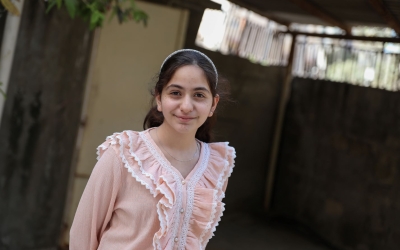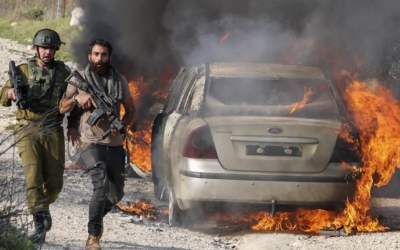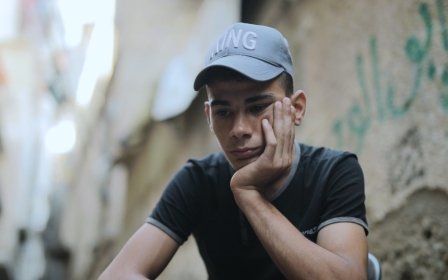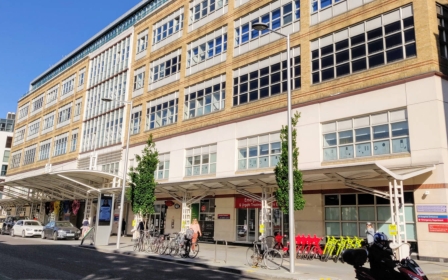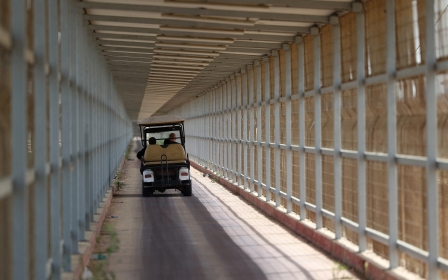Even with Palestinian children's art, Israel must make itself the victim

Here are two seemingly incompatible scenarios. The first is the horrendous and unconstrained violence currently being unleashed on Palestinian citizens, their homes, towns and villages by Israeli settlers whose representatives now occupy key positions in the Israeli government.
Israeli commentators have used words such as "pogrom" and "Kristallnacht" to describe the murder and destruction inflicted on unprotected civilians and their property.
If the usual method of accusing individuals or institutions of antisemitism does not fit, then the argument is used that British Jews should not be troubled by discomfort when confronted by the consequences of Israel’s actions
The second is an episode far away in a genteel part of London, where a British pro-Israel charity has somehow managed to pressure the Chelsea and Westminster Hospital into removing from one of its corridors an exhibition of art by Palestinian children from the Gaza Strip.
The UK Lawyers for Israel group submitted a complaint to the hospital it said "on behalf of some Jewish patients, who said that they felt vulnerable and victimised by this display". A UKLFI director commented: "We are pleased that the display has been removed and that the hospital has responded positively to its patients’ complaints."
But what could possibly be a rationale for Palestinian children’s art, with its expressions of hopes and dreams, of community, of love of the land, of fear and suffering, to be perceived as such a threat to the equanimity of a few Jewish supporters of Israel that it had to be removed?
New MEE newsletter: Jerusalem Dispatch
Sign up to get the latest insights and analysis on Israel-Palestine, alongside Turkey Unpacked and other MEE newsletters
In my view, one connecting thread is a familiar pattern: the more extreme and violent Israel’s behaviour and the more human rights violations it commits, the harder it has to work to portray itself to the outside world as a victim (with "the right to defend itself") - and the more assiduously do its defenders in the UK and elsewhere attempt to neutralise dissent by evoking victimhood or distress among the wider Jewish population.
If the usual method of accusing individuals or institutions of antisemitism does not quite fit, then the argument is used that British Jews should not be troubled by discomfort when confronted by the consequences of Israel’s actions.
Representations of suffering
It is entirely understandable that many Jews who have strong attachments to Israel experience distress and discomfort when faced with evidence of its crimes. What is unacceptable is that pro-Israel bodies in the UK seize upon these experiences in order to close down representations of suffering or depictions of such crimes.
Reading about Chelsea and Westminster Hospital’s decision to remove the art display, I was reminded of presentations I have given to other therapists about working with a team that treats traumatised children and families in Gaza. On each occasion, concerns were voiced in advance that describing such work could be "divisive", "inflammatory" or lead to some people feeling "very uncomfortable" and "marginalised".
One such set of objections occurred in May 2021, less than a week after bombs had been raining down on the citizens of Gaza, resulting in the deaths of 66 children and traumatising thousands of others.
Then, as now, elevating the hurt or distress of those who might be offended by naming Israel’s crimes above the need to bear witness to the victims of those very crimes - an assumption that is also offensive to Jews - is a toxic distortion that can, in my view, only be understood as racism.
This is another connecting theme between the two disparate events described earlier.
Racism is hard-wired into settler-colonial regimes because the drive to evict the indigenous people from their lands inevitably involves dehumanising those who are driven out. This "logic of elimination", as Australian historian Patrick Wolfe termed it, has much in common with earlier practices in Australia, the USA, Canada and South Africa.
Israel, as a 20th- and 21st-century settler-colonial state, needs to draw upon, in addition to violence, modern techniques of hyper-regulation, surveillance, monitoring and hasbara (propaganda).
The level of hyper-vigilance displayed by some pro-Israel groups in the UK is the counterpart of the hyper-surveillance inflicted on Palestinians in the occupied territories. Through hasbara, Palestinians, including children, are constructed by Israel and its apologists as either terrorists themselves or - in the case of younger children - as indoctrinated into violence by their elders.
'Unchilding'
The refusal to see Palestinian children as human beings possessed of their own subjectivities, hopes, fears and desires for life is aptly captured in Palestinian academic Nadera Shalhoub Kevorkian’s concept of "unchilding" - the process whereby the Israeli state perpetrates violence at many different levels against Palestinian childhood, confining children to "non-living spaces, produced by rendering lands, bodies, and lives exterminable and disposable".
The complaint about the exhibition of children’s art is a perfect illustration of "unchilding", containing as it does the insinuation that this art is both a threat in its own right to Jewish citizens’ peace of mind and also serves as the pawn of adults with nefarious intentions.
In other words, this approach - in my view - exactly mirrors the Israeli view that Palestinian children have to be responded to as if they are not really children at all and thus merit no empathy, and that sympathy should be reserved for those who feel threatened by them.
UKLFI said that they "asked for the artwork to be removed because of the propaganda, not because it was by children from Gaza".
They complained specifically about two notes. First one read: "Fishing with nets is one of the oldest industries in Palestine. The shoreline stretches for 224km from Rafah in the south to Ra’as al Naqoura in the north." "Thus," UKLFI wrote, "the existence of Israel is totally denied and 'Palestine' is regarded as covering the entirety of Israel."
The second note was the picture on the plate accompanying the text shows the Dome of the Rock with a large Palestinian flag, "implying that Jerusalem and in particular the site of what had been the Jewish Temple, would be part of a Palestinian state".
This complaint-in my view- callously disregards the inevitable desire of Palestinian youth, especially in the besieged and blockaded open-air prison that is Gaza, witnessing the day-to-day shrinkage of their land, to revive collective memories of the beloved landscape of historic Palestine and to insist on their continuing presence in Jerusalem.
Vision of the lost land
Despite the expectation of early Zionist state-builders that Palestinians would forget their dispossession, this vision of the lost land has remained strong over the generations. It involves a reclaiming of territory that is both material and spiritual. It does not relate to any particular political blueprint but is an inevitable response to settler colonialism.
Likewise, the 2018 "Great March of Return" was both a physical attempt to break out of the illegal blockade imposed on Gaza by Israel since 2007, and a powerful symbolic representation of the right of return of Palestinian refugees, a right enshrined in UN resolution 194.
Palestinian children in Gaza, aged 16, will have experienced six major attacks on their overcrowded, vulnerable environment, resulting in horrific loss of life and the destruction of houses, schools, hospitals, mosques, factories and power stations.
It is essential to grasp what this deliberate inflicting of death and destruction does to the soul as well as the body. The bombing of the Said al-Mishal theatre in 2018 was another cruel act, an assault on the culture that brings nurture to a people under siege. The theatre was a precious resource for Gaza children. The attack was not just on a building but on the space for aesthetic appreciation, for fun, and for the joyful release that the performance arts bring.
The artworks in Chelsea, with their moving evocations of Palestinian life, likewise demonstrated a yearning for beauty. The ugliness of the physical destruction of the homes and public spaces of Gaza is now paralleled by the ugliness of these bullying attempts to destroy yet another part of the soul.
Finally, we need to consider the health, mental and physical, of the children of Gaza and what can be done to sustain it. It is a profound irony that the artwork removed was in a hospital's children’s department, providing the excellent healthcare that Gaza children have no hope of accessing.
Around 90 percent of Gaza’s children are considered to be showing symptoms of trauma, a trauma which is never "post" but relentlessly ongoing and reactivated.
Among the factors that support resilience in children is the sense of being connected to an outside world, of not being forgotten, and that there are people who witness and care about your suffering. This is why an exhibition celebrating Gaza's children’s creativity is so important.
The head of the Chelsea and Westminster Hospital School understood how crucial these connections were when she acknowledged the impact of "bringing children together to share their experience of life".
These vital connections and the evidence they bring of the vibrant culture and values of Palestinian life, preserved and nurtured over the generations, serve as a constant challenge to Israeli domination and, just as within Palestine itself, their manifestations outside are vulnerable to attack and attempts at erasure.
The pressure exerted on Chelsea and Westminster Hospital to remove the artwork by Gaza children, with its threat of legal action, maybe a small event compared with what is happening in Palestine, but, it illustrates, in my view, the length to which Israel's friends in this country will go to whitewash its abuses and demonise its victims.
The views expressed in this article belong to the author and do not necessarily reflect the editorial policy of Middle East Eye.
Middle East Eye delivers independent and unrivalled coverage and analysis of the Middle East, North Africa and beyond. To learn more about republishing this content and the associated fees, please fill out this form. More about MEE can be found here.



